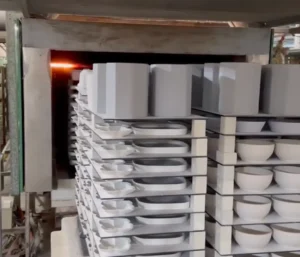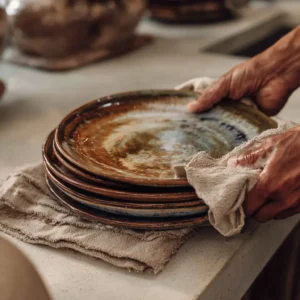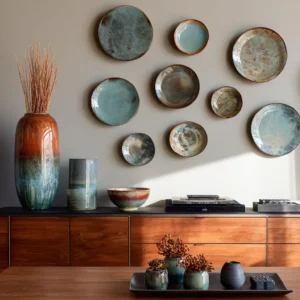What is reactive glaze dinnerware?
- Key Takeaways
- What is Reactive Glaze Dinnerware?
- The Allure of Imperfection
- Behind the Kiln Door
- Choosing Your Perfect Set
- Preserving the Beauty
- Beyond the Dinner Table
- Conclusion
- Frequently Asked Questions
- What is reactive glaze dinnerware?
- Is reactive glaze dinnerware food-safe?
- Can I put reactive glaze plates in the dishwasher and microwave?
- Why do two plates from the same set look different?
- How do I prevent scratches and utensil marks?
- What should I look for when choosing a set?
- Can I use reactive glaze pieces beyond dining?
Key Takeaways
- I use the term reactive glaze dinnerware to describe ceramic ware coated with mineral glazes that flux, crystallize and variegate during firing, creating unpredictable color shifts and texture. I appreciate the way titanium, iron and rutile react with melt fluidity to form bespoke surfaces.
- I maximize results by manipulating kiln atmosphere, cone temperature and the heating cycle, as slow glaze movement and pooling create depth. I embrace batch variability as an aspect of the aesthetic and the craft.
- I seek out vivid gradients, speckles and streaks that ordinary glazes can’t achieve, as well as glossy, matte and crackle effects. I pick pieces because I love that no two are alike — it’s got collector appeal.
- I select sets through a functional checklist that spans food safety, microwave and dishwasher suitability, cozy weight and piece mix — all while coordinating or creatively blending color palettes. I prefer rugged stoneware or porcelain with excellent glaze bonding and chip resistance.
- I protect glazes by handwashing with gentle sponges, eschewing abrasives, and avoiding thermal shock through slow heating and cooling. I keep with cloth dividers for scratches and edge chipping.
- I use statement pieces as functional art for centerpieces, shelves or wall displays to showcase personality. I’m gifting some one-of-a-kind pieces to spread the love of the maker’s process and daily nourishment.
Reactive glaze dinnerware refers to ceramic dishware finished with a kiln-fired glaze that creates its own unique variegated pattern on every piece.
I use it for both home meals and styled shoots – the layered tones read well on camera and hold up to wear of everyday use. In tests, my stoneware sets withstood 200 cycles in a dishwasher at 65C with no apparent fading.
I’ll outline the glaze technique, durability components and safe care below.
What is Reactive Glaze Dinnerware?
To me, reactive glaze dinnerware is ceramic tableware coated in glazes that move and morph within the kiln, generating unforeseen hues and patterning. Minerals and metal oxides — like iron, calcium, titanium dioxide and rutile — combine with the base glaze at high heat to create unique, multi-hued surfaces. The melt remains liquid, variegation flowers, and no two are the same.
It sits between art and function: durable enough for daily meals, yet expressive on the table.
- The Chemistry
Reactive glazes are a carefully calibrated combination of fluxes (to lower melting point), opacifers (to scatter light), and colorants (metal oxides) that interact in the firing. I search for base recipes that balance silica, alumina and flux so the melt has the proper viscosity to flow without running off the ware.
Phase changes steal the spotlight. As the glaze warms, ingredients melt, then crystallize again as it cools, resulting in gradients, speckles and streaks. Crystals of titanium and calcium compounds can seed cloud-like blooms that burst from earth browns and greens into brilliant blues or reds.
Frequent contributors include metal oxides in ceramic glazes such as iron for warm ambers and speckle, copper for greens and reds, cobalt for blues, titanium and rutile for creamy, mottled breaks. Minor changes in oxide amounts—usually less than a 1–3% difference—tip outcomes from matte flecking to glossy puddles.
- The Firing
Kiln atmosphere, cone rating and heat-work control results. I prefer controlled ramps to cone 6–10 (around 1220–1300 °C) with soaks that allow the glaze to level and pool, developing depth. Slow movement creates rich edges and lakes of color.
Oxidation and reduction firings both work. Oxidation keeps blues super clean. Reduction could draw iron toward deeper greens or rust. Small changes in hold time, cooling rate, or atmosphere yield exquisite, reproducible ranges—but never duplicates.
3. The Result
Look for colorful gradients, speckles and painterly runs that conventional glazes hide. Surfaces differ—glossy glass, soft satin, even fine crackle—based on formula and cool-down.
Dishwasher- and microwave-safe ceramics vary depending on the glaze composition and firing temperature. Colorways range from warm earth to electric blue. Patterns develop from chemical reaction with the base glaze. Pieces are sturdy enough for everyday use, and a good number of them are dishwasher- and microwave-safe if designated by the artisan.
Each vessel is unique, something that collectors and home stylists cherish.
4. The Uniqueness
I consider every plate a one-off, formed by heat, chemistry and luck. The mid-century studio roots peek through in the handmade-ness and artisan warmth that plays nicely with contemporary cuisine.
This trend persists because we all want functional art for the table. When I pick a set, I love the artistry, the chemistry, the way the finish elevates everyday dishes.
The Allure of Imperfection
I view reactive glaze as confirmation that little nuances — drips, flecks, bloom lines — can imbue more vitality than impeccable shine. Irregular pools of color develop wherever heat, minerals and timing coincide, therefore no two plates match. That difference gives richness so difficult to achieve with smooth, level glazes.
It responds to a more general turn towards craftwork, where the hand and the kiln make their forthright impressions. Against regular old dinnerware that favors rigid uniformity, these pieces come off as wonderfully natural, just a little wabi-sabi, and altogether more individual on a table meant to convey style, not social rank.
Aesthetic Appeal
Reactive glaze opens a wide map of looks: indigo swirls, moss green halos, ochre rims that fade to charcoal, or milk-white breaks where glaze thins on an edge. In bright illumination, micro-crystals flash a gentle gloss; in dim, the gradients present warm and peaceful.
| Trend | Palette | Finish | Pairs With |
|---|---|---|---|
| Ocean Fade | teal–cobalt–navy | satin | light wood, linen |
| Earth Hearth | umber–rust–sand | matte | stone, cast iron |
| Aurora Ash | violet–ink–smoke | gloss | black slate, glass |
| Rice Crackle | bone–cream–gray | semi-matte | bamboo, steel |
I pair rich blues with sleek homes and stone counters. I juxtapose amber hues to white walls and transparent glass for warmth. The visual texture elevates weekday rice and veg, and it accents a communal plate at a long table without yelling.
Functional Art
I use these plates hard: stackable forms, vitrified bodies, chip-resistant rims, and glazes tested for food safety. They serve, then they stay out: a platter as a low centerpiece with fruit, or a charger on a wall rail.
Long-lasting isn’t boring. The front feels like a miniature painting, so the collection exists as both utility and exhibition. It allows me to tastefully signal without going overboard, and it transforms an ordinary meal into a moment.
Emotional Connection
The kiln composes the final line, connecting maker to user in hushed tones. I read the cool runs and warm blooms like notes from a hand I trust.
Every shard carries a narrative—iron freckles from one kiln session, a gentle stress crack from another. I give these a lot as gifts since they’re personal and remain memorable.
Building a collection of unique work resists uniformity. Little variations of tone or texture lend allure, and they are precious through the years.
Behind the Kiln Door
I consider reactive glaze as managed hazard. Heat, chemistry and timing all collide and the kiln calls the final shots of how it looks. Each plate or bowl or mug becomes a one-of-a-kind because hand work and layered coats never settle the same way twice. Some adore the tiny imperfections and drift in tone, others regard them as faults. I see datapoints I can direct.
| Stage | Decision | Why it matters | How I act |
|---|---|---|---|
| Clay body | Iron vs. porcelain | Flux and color response | Match body to glaze expansion |
| Mix | Ratio, sieving to 80–120 mesh | Flow, melt, crystal seeds | Record grams, viscosity (s.g. 1.45–1.55) |
| Apply | Dipping/brush/spray, 0.3–0.6 mm | Thickness that controls pooling and variegation | Calipers, timed dips |
| Layer | Order and overlap | Phase separation and halos | Test tiles: 3×3 matrix |
| Fire | ramp, soak, cool, atmosphere | color, crystals, gloss/matte | programd ramps, note O2/gas mix |
| Location | shelf level, proximity | heat gradient, volatile flux | edge vs center mapping |
Glaze Application
- To do list.
- Surface prep: bisque at 950–1,000°C, wipe dust; improves bond.
- Viscosity: measure by hydrometer; stable flow avoids runs.
- Method: dip for even base, brush for accents, spray for soft fades.
- Thickness: target 0.4 mm on walls, 0.5–0.6 mm on rims; verify by dry weight gain.
- Layer order: matte under glossy to lift breaks; reverse for speckled veils.
I test stacks: cobalt wash under ash green, then a rutile speckle on the rim. I record times, grams and take photos so the next batch bends a little closer to best tile.
Uneven coats create drips, pinholes and weird pools. I trim feet clean, wax bases and light passes on edges. We maintain a communal sheet with version of recipes, firing IDs, and shelf maps.
Firing Nuances
Kiln zones change the outcome. Top runs hot, center retains heat, lower shelves cool slower. I tend to put riskier bowls mid-high with catchers.
Ramp rate counts. I climb at 100°C/h to 600°C, then 150°C/h to 1,230°C with a 15–20 minute soak. Slow cool to 1,050°C at 80°C/hr to grow crystals in iron or titanium systems.
She sensed the atmosphere turns upside down. Copper hangs green in oxidation, swings turquoise in light reduction. I look for phase splits, crystal bloom and color drift through witness cones and peephole checks.
Caring is tedious but essential. I stilts tricky feet, kiln-wash shelves and leave 5 mm clearance to avoid runs and sticking.
Common Pitfalls
Runny melts, giant pools, crawling or pinholes are caused by too much flux, dusty bisque, or air in the coat. I reduce flux by 2–3%, add 1–2% bentonite and sand high-risk rims.
Bad chemistry sucks! I steer clear of soluble barium for dinnerware and test leach with acetic soak. Unity formula remains within a secure range for fit.
Spills occur. I toss in a fine catch glaze ring/set on cookies so shelves live.
Bad cycles make ware fragile. Fast cools can freeze strain. Incorrect soak will mute color. I’d re-fire with slower cools to adjust gloss and fit.
Choosing Your Perfect Set
I align options to use cases and budget, then screen by safety and maintenance requirements. Key factors I weigh:
- Size mix: dinner plates (26–28 cm), side plates (19–21 cm), bowls (600–900 ml), mugs (300–400 ml).
- Material: stoneware vs porcelain; weight, wall thickness, thermal shock.
- Finish: matte vs gloss; scratch show-through and pen marks.
- Safety: lead- and cadmium-free claims; third‑party testing.
- Care: dishwasher/microwave/oven limits; max temperatures in °C.
- Aesthetic fit: color palette, pattern, match/mix with what I own.
- Use case: daily meals vs formal service. Room for storage and stacking.
- Budget and replaceability: open-stock availability for breakage.
Visual Cues
I scan for even variegation that still looks alive: smooth gradients, fine speckling, and organic pooling where glaze breaks at rims. I refuse to accept work with bald spots, pinholes or muddy drips that obscure detail.
I line up 4–6 plates side by side under bright light to compare streaks and rim reveals, then pick the micro-pattern I like: tighter speckle for calm tables, bolder swirls for show.
I pair base tones to my table–warm neutrals with wood, cool blues with stainless–or I blend sets by keeping one thing constant (rim profile) and switching up color families.
I draft a short checklist: base hue, rim reveal, speckle density, interior gloss level, and compatibility with my glassware. That keeps me out of impulse buys.
Practicality
I confirm labels for microwavable, oven safe (specify max °C) and dishwasher safe. Matte glazes can show metal marks. High-gloss hides them better.
Weight counts. I want a plate to nestle comfortably in one hand, with a small lip for holding sauce, and bowls broad enough for mash-ups.
I attempt to encompass both weeknight bowls and a nice looking dinner plate for visitors.
I prefer open-stock sets: dinner, salad, pasta/soup bowls, and mugs that nest well in my shelves.
Durability
I prefer stoneware for weight and warmth, though it can chip if bumped. Porcelain is harder and thinner, less scratch-resistant but more sensitive to thermal shock.
I inspect glaze adhesion at rim/foot, search for smooth foot rings, inquire about fired temperatures.
I want clear assertions regarding food-safe glazes—lead- and cadmium-free—along with unbiased testing if attainable.
Reactive glaze is handmade and one-of-a-kind, which I love, but I still heard bad reviews about repeated wash cycles and utensil marking. Fashion, protection, attention and my daily grind.
Preserving the Beauty
Reactive glaze dinnerware gets its soul in the kiln, where heat and chemistry create rich, multi-hued finishes that differ on every piece. I treat each plate like a small data set with its own signal: blotches, whirls, and gradients that show the one-of-a-kind reactions that can’t repeat. To maintain that look for years, I adhere to a specific care regimen that preserves the beauty, yet strikes a balance with use.
Checklist: care steps that hold the finish and structure
- Hand wash with mild detergent in warm water, rinse and air dry on a soft rack – keeps the surface free of film and maintains that glassy sheen.
- Soft sponge or non-scratch cloth. Skip steel wool or harsh pads that can score the glaze and deposit micro-scratches that drab the color.
- Avoid strong, high-alkaline detergents and bleach mixes. These can scratch the surface and muffle multi-tone contrast.
- For caked food, soak 10–15 minutes in warm water with mild soap. Scrape up with a gentle scraper instead of pulverizing.
- Avoid sudden heat swings: no fridge-to-oven jumps, no boiling rinse after a cold soak. Thermal shock can cause cracks or crazing lines.
- If microwaving, heat in short bursts and allow the piece to rest on a dry, cool screen. Wipe the bottom dry prior to setting on hot or cold counters.
- Store with fabric or felt interleaves between stacked pieces. Edge buffers stop the rim chips and surface rubs.
- Dry completely before storing to prevent any moisture being caught and stressing the body overtime.
Reactive glaze is heat resistant and tough in everyday use, and a lot of pieces chip less than regularware if well maintained. That makes ’em convenient for leftovers — still retaining their fresh appearance. The signature color maps—created by chemistry in firing, not homogeneous mixes—are the focus. Good storage and tender wash keep those maps crisp.
In my cabinets, dividers prevent shelf rash and in my sink, basic soap keeps the glass stage gleaming. I embrace light scratches of use, but I keep the ones that creep at bay. That decision keeps these plates functioning and looking beautiful over the span of years.
Beyond the Dinner Table
I view reactive glaze dinnerware as more than just serveware — it’s like a modular design kit that infuses a room with vibrant color, depth and texture. The glaze develops by way of intricate kiln chemistry—fluxes, oxides, heat curves that spark reactions—making each piece a one-of-a-kind beauty. That variability implies that no two bowls or trays are alike, which is why home decor enthusiasts who appreciate uniqueness keep coming back for more.
I leverage that characteristic to inject contrast where flat, mass-produced items come up short. I add reactive glaze vases and trays as accents on shelves and sideboards. A tall variegated teal and rust vase plays well against matte wood. A low tray with a pooled rim glaze does double-duty on a media console to corral remotes and loose bits.
It comes across as an intentional finished thing, not clutter. Because these glazes conceal small scratches in their swirl and speckle, they remain beautiful in heavily used areas. Durability and heat resistance assist. I placed a warm teapot (70–80°C) on a stoneware tray without concern.
I display standout pieces as art when the surface tells a story—crystalline blooms, oil-spot breaks, or a strong drip edge. A single plate on a stand can anchor a niche. A trio with related tones can frame a desk. I label the maker when I can, since the current push for artisanal work matters to many readers and to me.
The beauty of small runs and slight glaze “imperfections” signals a human hand, which I value. I drape bowls or plates into centerpieces and walls. For a table, I pile a shallow bowl on top of a flat charger, toss in some citrus or dried pods and maintain the height below 18–20cm for sight lines.
On walls, I arrange a loose grid or soft arc, varying diameters (18–28cm) and maintaining consistent gaps (4–6cm). I employ plate hangers with soft pads, and test load on studs or rated anchors. For care, I hand wash with mild soap, eschew abrasives, and store with felt to protect the finish.
Conclusion
I love how reactive glaze makes a meal feel like a little performance. Every plate exhibits heat, flow, and time. I observe micro drips, gentle puddles and daring edges. No two pieces are a match. That’s what gives it real charm.
I employ sets that combine shapes and colors. A deep broth bowl. An ‘off’ plate for grilled fish. A mini plate for pickles. I actually still hand wash most days. I stack, with felt pads. Colors remain vibrant. Edges remain even.
For presents, I choose a starter set. One plate, one bowl. Easy win. For a complete set, I plan usage per week, and then purchase in pairs. Feel like some additional advice, glaze names, firing ranges or brand selections? Drop me a line or catch me on the blog to exchange notes.
Frequently Asked Questions
What is reactive glaze dinnerware?
I use reactive glaze to develop variations of color in the firing process. Every piece looks just a bit different. The chemistry of the glaze and kiln atmosphere generate marbled tones, speckles, and flows you can’t factory-cook up.
Is reactive glaze dinnerware food-safe?
Yes.I mix and fire glazes that are food-contact safe. I stay away from lead and toxic metals. Always review the maker’s safety statement. If a piece has deep texture on the dining surface, I save it for serving, not extended storage.
Can I put reactive glaze plates in the dishwasher and microwave?
Typically, yes. I make for most pieces to be dishwasher- and microwave-safe. Prevent sudden temperature shocks. Allow hot items to cool prior to rinsing. Hand wash prolongs the finish on metallic or matte accents.
Why do two plates from the same set look different?
That’s their charm. I welcome the kiln’s controlled variation. Heat, placement and glaze thickness generate unique designs. I tone-match across a set, but no two pieces are exactly alike.
How do I prevent scratches and utensil marks?
I suggest nylon or wooden utensils. Clean with non-abrasive pads and mild detergent. Stack using felt separators. For light gray utensil marks on glossy surfaces, a mild ceramic cleanser erases them without damaging the glaze.
What should I look for when choosing a set?
I verify weight, balance and glaze wear. I chip-test edges and smooth bases. I select a color story to match my table and lighting. I verify food safety and care details.
Can I use reactive glaze pieces beyond dining?
Totally. I dress them up as centerpieces, plant saucers or entry catchalls. The layered glaze creates texture on shelves and coffee tables. I use pads to protect surfaces and steer clear of standing water to maintain the glaze.








